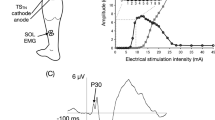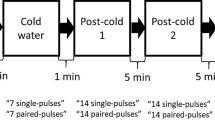Abstract
The effect of transcutaneous electrical nerve stimulation (TENS) on the central nervous system amplification process was investigated focusing on the dorsal column-medial lemniscal pathway, because the dorsal column nucleus was recently shown to receive multiple sources of sensory information, including pain. Short latency somatosensory evoked potentials (SSEPs) were recorded in ten healthy normal volunteers. Amplitude changes in each SSEP component (the N9 brachial plexus potential, the P14 potential that originates from the cervicomedullary junction, spinal N13/P13 generated by the cervical dorsal horn and the cortical N20/P25 potential) were studied at stimulus strenghts ranging from the threshold (40% maximum stimulus) to 2.5 times the threshold (maximum). The findings suggest that sensory amplification begins at the P14 generator source near the cuneate nucleus. There was no statistically significant difference in sensory amplification between P14 and cortical N20/P25, indicating that the cuneate nucleus is the main site of the central amplifying process. When TENS was applied to the palm distal to the median nerve stimulation used for SSEP, cortical N20/P25 amplification disappeared, evidence that TENS suppresses the central amplification phenomenon, most probably at the level of the cuneate nucleus.
Similar content being viewed by others
References
Berkley KJ, Hubscher CH (1995) Are there separate central nervous system pathways to touch and pain? Nat Med 1:766–773
Campbell A (1973) Local analgesia from electrical stimulation. Arch Neurol 28:347–350
Eisen A, Elder G (1980) Sensory nerve stimulation and evoked cerebral potentials. Neurology 30:1097–1105
Eisen A, Purees S, Hoist M (1982) Central nervous system amplifications: its potential in the diagnosis of early multiple sclerosis. Neurology 32:359–364
Garrison DW, Foreman RD (1994) Decreased activity of spontaneous and noxiously evoked dorsal horn cells during transcutaneous electrical nerve stimulation (TENS) Pain 58:309–315
Golding JF, Ashton H, Marsh R, Thompson JW (1986) Transcutaneous electrical stimulation produced variable changes in somatosensory evoked potentials, sensory perception and pain threshold: clinical implication for pain relief. J Neuro Psychiatr 49:1397–1406
Janig W, Schoultz T, Spencer WA (1977) Temporal and spatial parameters of excitation and afferent inhibition in cuneothalamic relay neurons. J Neurophysiol 40:822–835
Kandel ER, Schwartz JH (1991) Directly gated transmission at central synapses. In: Kandel ER, Schwartz JH, Jessell TM (eds) Principles of neural science, 3rd edn. Elsevier, New York, pp 153–172
Kashiwagi T (1981) Medical statistical analysis (in Japanese). Asakura Shoten, Tokyo, pp 98–104
Macefield G, Burke D (1991) Long-lasting depression of central synaptic transmission following prolonged high-frequency stimulation of cutaneous afferents: a mechanism for post-vibratory hypaesthesia. Electroencephalogr Chin Neurophysiol 78:150–158
Melzack R, Wall PD (1965) Pain mechanism: a new theory. Science 150:971–979
Nardone A, Shieppati M (1989) Influences of transcutaneous electrical stimulation of cuntaneous and mixed nerves on subcortical and cortical somatosensory evoked potentials. Electroencephalogr Chin Neurophysiol 74:24–35
Urasaki E, Wada S, Kadoya C, Matsuzaki H, Yokota A, Matsuoka S (1988) Absence of spinal N13-P13 and normal scalp far-field P14 in a patient with syringomyelia. Electroencephalogr Chin Neurophysiol 71:400–404
Urasaki E, Wada S, Kadoya C, Tokimura T, Yokota A, Matsuoka S, Fukumura A, Hamada S (1990) Skin and epidural recording of spinal somatosensory evoked potentials following median nerve stimulation: correlation between the absence of spinal N13 and impaired pain sense. J Neurol 237:410–415
Urasaki E, Wada S, Kadoya C, Yokota A, Matsuoka S (1990) Spinal intramedullary recording of human somatosensory evoked potentials. Electroencephalogr Chin Neurophysiol 77:233–236
Urasaki E, Wada S, Kadoya C, Yokota A, Matsuoka S, Shima F (1990) Origin of scalp far-field N18 of SSEPs in response to median nerve stimulation. Electroencephalogr Chin Neurophysiol 77:39–51
Urasaki E, Tokimura T, Kumai J, Wada S, Yokota A (1992) Preserved spinal dorsal horn potentials in a brain-dead patient with Lazarus’ sign. Case report. J Neurosurg 76:710–713
Wall PD, Sweet WH (1967) Temporary abolition of pain in man. Science 155:108–109
Ware JH, Mosteller F, Ingelfinger JA (1995) P values. In Bailar JC III, Mosteller F (eds) Medical uses of statistics (in Japanese), 1st edn. Scientist-sha, Tokyo, pp 125–141
Yamada T, Muroga T, Kimura J (1981) Tourniquet-induced ischemia and somatosensory evoked potentials. Neurology 31:1524–1529
Author information
Authors and Affiliations
Rights and permissions
About this article
Cite this article
Urasaki, E., Wada, Si., Yasukouchi, H. et al. Effect of transcutaneous electrical nerve stimulation (TENS) on central nervous system amplification of somatosensory input. J Neurol 245, 143–148 (1998). https://doi.org/10.1007/s004150050194
Received:
Revised:
Accepted:
Issue Date:
DOI: https://doi.org/10.1007/s004150050194




